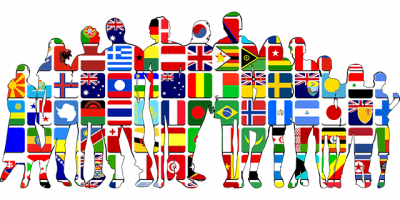
What is Race?
 DSVS is committed to infusing philosophies and concepts of racial and social equity into our practices, policies and services. One way we are fulfilling this commitment is by including an equity feature in Volunteer Voices, which will help us (volunteers and staff) engage in discussions about racial and social equity, apply an equity focus in all that we do and create, and become more knowledgeable about mitigating inequity so DSVS resources and services are fair and just for everyone, regardless of identities and circumstances. In accordance with One Fairfax, “we all do better when we all do better.”
DSVS is committed to infusing philosophies and concepts of racial and social equity into our practices, policies and services. One way we are fulfilling this commitment is by including an equity feature in Volunteer Voices, which will help us (volunteers and staff) engage in discussions about racial and social equity, apply an equity focus in all that we do and create, and become more knowledgeable about mitigating inequity so DSVS resources and services are fair and just for everyone, regardless of identities and circumstances. In accordance with One Fairfax, “we all do better when we all do better.”
As we consider issues of racial and social equity, it is essential to understand foundational concepts. Throughout time, “race” has been a commonly misunderstood and misconstrued term. Race is a social construct that is not biologically defined. It does not reside in nature, but in politics, economics and culture. Social institutions make and perpetuate race by disproportionately channeling resources, power, status and wealth to the majority, which is white people.
Our eyes tell us that people look different. But what do those differences mean? Has the idea of race always been with us? Is skin color more than skin deep? How does race affect people today?
There’s less–and more–to race than meets the eye:
1. Race is a modern idea. Ancient societies, such as the Greeks, did not divide people according to physical distinctions. The English language did not have the word “race” until 1508.
2. Race has no genetic basis. Not one characteristic, trait or gene distinguishes all the members of one so-called race from all the members of another so-called race. According to the Smithsonian National Museum of Natural History, the DNA of all human beings living today is 99.9% alike.
3. Human subspecies don’t exist. Unlike many animals, modern humans simply haven’t been around long enough or populations isolated enough to evolve into separate subspecies or races. Despite surface appearances, we are among the most similar of all species.
4. Skin color really is only skin deep. Most traits are inherited independently from one another. The genes influencing skin color have nothing to do with the genes influencing hair form, height, blood type, musical talent, athletic ability or forms of intelligence. Knowing one trait, like skin color, doesn’t necessarily tell you anything else about a person’s other traits.
5. Most variation is within, not between, "races." Of the small amount of total human genetic variation, 85% exists within any local population. For example, that means two Koreans may be as genetically different as a Korean and an Italian.
6. Slavery predates race. Throughout much of human history, societies have enslaved others, often as a result of conquest or war, even debt, but not because of physical characteristics or a belief in natural inferiority. Due to a unique set of historical circumstances, ours was the first slave system where all the slaves shared similar physical characteristics.
7. Race and freedom evolved together. The U.S. was founded on the radical new idea that “All men are created equal.” But our early economy was based largely on slavery. How could this anomaly be rationalized? The new idea of race helped explain why some people could be denied the rights and freedoms that others took for granted.
8. Race justified social inequalities as natural. As the idea of race took hold, white superiority became “common sense” in white America. It rationalized not only slavery, but also the extermination of Native Americans, exclusion of Asian immigrants and the taking of Mexican lands. Racialized practices became institutionalized within American government, laws and society and persist even though government-enacted segregation ended.
9. Race isn’t biological, but racism is still real. Racism is a powerful social force that gives people different access to opportunities and resources. Our government and social institutions disproportionately, albeit often invisibly, channel wealth, power and resources to the majority, white people. This affects everyone, whether we are aware of it or not.
10. Colorblindness will not end racism. Pretending race doesn’t exist is not the same as creating equality. Colorblindness relies on the concept that race-based differences don't matter, ignores the realities of systemic racism and creates feelings of invisibility for people of color. Racism is more than stereotypes and individual prejudice. To tackle racism, we need to identify and remedy social policies and institutional practices that advantage some groups at the expense of others.
*Adapted from RACE - The Power of an Illusion, produced by California Newsreel in association with the Independent Television Service
—Alaha Ahrar, Keesha Coke, Gretchen Soto
This article posting is part of the Domestic and Sexual Violence Services' Volunteer Voices monthly newsletter for current and potential volunteers. If you're not already a volunteer, learn how to get involved. Find out about upcoming trainings, volunteer trainings, happenings around the DSVS office and information about articles, books, media recommendations and more.
Learn more about the Domestic and Sexual Violence Services (DSVS).

